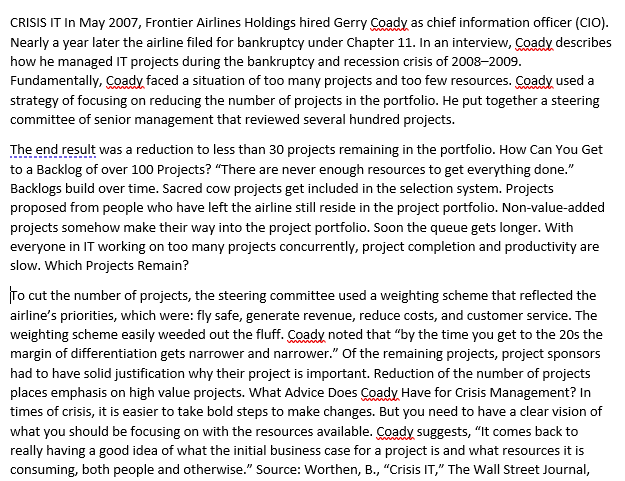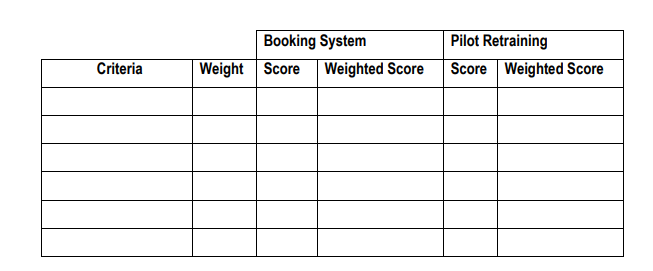To cut the number of projects, the steering committee used a weighting scheme that reflected the airline’s priorities, which were: fly safe, generate revenue, reduce costs, and customer service. The weighting scheme easily weeded out the fluff.” Use a weighted scoring model to help the committee choose between two projects: Booking System Upgrade and Cabin Crew Retraining. The relative weights for each criterion and the assessment of each project for these criteria are shown in the following table. Which project would you choose and why? (See extract attached to assist) (Assume 10 represents the preferred score and 1 represents the undesired score.) Criteria Weight Booking System Upgrade Pilot Crew Retraining Fly safe 40 4 10 Generate revenue 30 9 9 Reduce costs 20 7 8 Customer service 10 10 10 Use the Template in the attached
To cut the number of projects, the steering committee used a weighting scheme that reflected the airline’s priorities, which were: fly safe, generate revenue, reduce costs, and customer service. The weighting scheme easily weeded out the fluff.” Use a weighted scoring model to help the committee choose between two projects: Booking System Upgrade and Cabin Crew Retraining. The relative weights for each criterion and the assessment of each project for these criteria are shown in the following table. Which project would you choose and why? (See extract attached to assist) (Assume 10 represents the preferred score and 1 represents the undesired score.) Criteria Weight Booking System Upgrade Pilot Crew Retraining Fly safe 40 4 10 Generate revenue 30 9 9 Reduce costs 20 7 8 Customer service 10 10 10 Use the Template in the attached
Management, Loose-Leaf Version
13th Edition
ISBN:9781305969308
Author:Richard L. Daft
Publisher:Richard L. Daft
Chapter11: Managing Change And Innovation
Section: Chapter Questions
Problem 3CFCA
Related questions
Question
100%
“To cut the number of projects, the steering committee used a weighting scheme that reflected the
airline’s priorities, which were: fly safe, generate revenue, reduce costs, and customer service. The
weighting scheme easily weeded out the fluff.”
Use a weighted scoring model to help the committee choose between two projects: Booking System
Upgrade and Cabin Crew Retraining. The relative weights for each criterion and the assessment of
each project for these criteria are shown in the following table. Which project would you choose and
why? (See extract attached to assist)
(Assume 10 represents the preferred score and 1 represents the undesired score.)
| Criteria | Weight | Booking System Upgrade | Pilot Crew Retraining |
| Fly safe | 40 | 4 | 10 |
| Generate revenue | 30 | 9 | 9 |
| Reduce costs | 20 | 7 | 8 |
| Customer service | 10 | 10 | 10 |
Use the Template in the attached

Transcribed Image Text:CRISIS IT In May 2007, Frontier Airlines Holdings hired Gerry Coady as chief information officer (CIO).
Nearly a year later the airline filed for bankruptcy under Chapter 11. In an interview, Coady describes
how he managed IT projects during the bankruptcy and recession crisis of 2008-2009.
Fundamentally, Coady faced a situation of too many projects and too few resources. Coady used a
strategy of focusing on reducing the number of projects in the portfolio. He put together a steering
committee of senior management that reviewed several hundred projects.
The end result was a reduction to less than 30 projects remaining in the portfolio. How Can You Get
to a Backlog of over 100 Projects? "There are never enough resources to get everything done."
Backlogs build over time. Sacred cow projects get included in the selection system. Projects
proposed from people who have left the airline still reside in the project portfolio. Non-value-added
projects somehow make their way into the project portfolio. Soon the queue gets longer. With
everyone in IT working on too many projects concurrently, project completion and productivity are
slow. Which Projects Remain?
To cut the number of projects, the steering committee used a weighting scheme that reflected the
airline's priorities, which were: fly safe, generate revenue, reduce costs, and customer service. The
weighting scheme easily weeded out the fluff. Coady noted that "by the time you get to the 20s the
margin of differentiation gets narrower and narrower." Of the remaining projects, project sponsors
had to have solid justification why their project is important. Reduction of the number of projects
places emphasis on high value projects. What Advice Does Coady Have for Crisis Management? In
times of crisis, it is easier to take bold steps to make changes. But you need to have a clear vision of
what you should be focusing on with the resources available. Coady suggests, "It comes back to
really having a good idea of what the initial business case for a project is and what resources it is
consuming, both people and otherwise." Source: Worthen, B., "Crisis IT," The Wall Street Journal,

Transcribed Image Text:Criteria
Booking System
Weight Score Weighted Score
Pilot Retraining
Score Weighted Score
Expert Solution
This question has been solved!
Explore an expertly crafted, step-by-step solution for a thorough understanding of key concepts.
Step by step
Solved in 2 steps with 3 images

Recommended textbooks for you

Management, Loose-Leaf Version
Management
ISBN:
9781305969308
Author:
Richard L. Daft
Publisher:
South-Western College Pub

Management, Loose-Leaf Version
Management
ISBN:
9781305969308
Author:
Richard L. Daft
Publisher:
South-Western College Pub